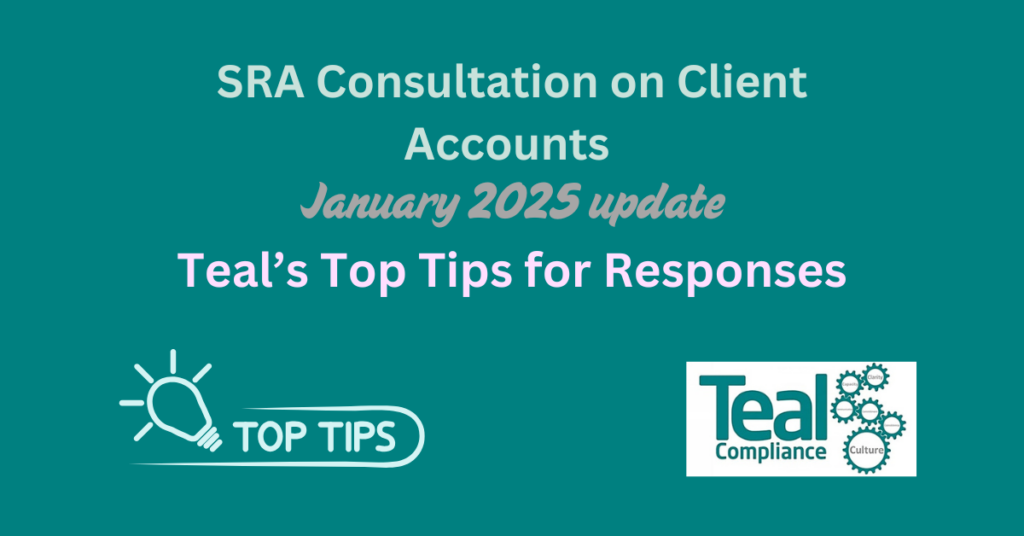Further to the SRA’s January Consultation latest round, Amy Bell at Teal Compliance would like to impart her insights best practice for responses.
It’s a hot topic for 2025 and beyond for law firms, their legal cashiers and compliance officers.
I ran an online debrief of the latest round of the SRA’s consultation on Wednesday 8 January 2025 and this article is an outline of the insights.
For those that don’t know me, I am the second time Chair of the Economic Crime Task Force (ECTF) and one of the roles of chairing this committee at the Law Society is that I need to assist with consultation responses. The SRA’s consultation is one that could have a significant impact on you and your practice. I wanted to share my insights that have been flagged within responses to the consultation and share my hints and tips for getting further consultation responses to the SRA effectively. One skillset I have learnt through my role in the ECTF is how to lobby persuasive arguments and how to make sure our arguments aren’t dismissed.
Content Guide for Top Tips
- Show the evidence
- Get Organised
- Don’t give false impressions
- It’s a fine line
How to construct a consultation response
How do we construct a consultation response which hits the right notation and points that are serious? Our questions are always valid, but sometimes that SRA assumes we are simply venting or ranting. I’m going to give you my tips on how best to get your point across.
Pre-Christmas I had a few people ask me if they believed the consultation was happening because the SRA didn’t manage Axiom Ince properly. If I’m honest, I don’t think it is specifically because of this as the SRA has had accounts rules on their agenda for quite a long time now. The Axiom case has definitely brought the conversation around law firms holding client monies on account into the forefront however.

When we look at the compliance officer and their roles and responsibilities, within the consultation, suggests that the SRA are going to do thematic work before they make any decisions.
One of my concerns (about any proposal to change anything) is, where’s the evidence?
If you want my top tips on guiding your response, then asking where the evidence is would be at the top of the list.
Where is the evidence for the point the SRA is making? Ask them to prove it to you.
As legal professionals, we do have accidents and human error mistakes. We also know that in regard to Axiom, they have been charged by the Serious Fraud Office in relation to that, and in the fullness of time, we will find out what happened.
Yes, something went terribly wrong there with client money, and the consequences are going to cost all of us in the profession through compensation it already has done through the contributions. However, it is an isolated issue.
New models of law firms with no client accounts
75% of law firms currently have a client account.
The more research I do however, shows that more and more firms are moving away from a client account. Our American firm colleagues that have launched practices in London tend not to have a client account at all.
What we know is that 1000 firms will have more than a million pounds in the client account at any one time.
There are approximately 3500 to 4000 firms that are servicing areas of high-volume transactional conveyancing work on a regular basis. If your firm offers conveyancing, you know client account changes are going to affect you.
Maybe you are in a regional firm, or a local high street practice that does conveyancing. When it comes to law firm risk by holding monies on client account, there are substantial sums of money being transacted, and the regulator is hot on your heels.
If you hold more than £100m, or as some do, more than £100b, on client account, your risk is high.
Of course, there are thousands of firms that hold less than £100,000 on client account, and keep it that way as a constant precaution. To those firms, it might not be such an issue for this consultation.
The bottom line and the question we need to ask is did we get the amendments to the Account Rules right? Maybe we didn’t.
One of conversational themes around the Accounts Rules is perhaps to take away some of the flexibility that the SRA sought to introduce back in 2019.
When we move to outcome-focus regulation and look deeper at specifics, law firm compliance professionals will embrace and go, yeah amazing! Specifics is where risk management can get behind and tell their senior partners and the overall business plan about.
That being said, by doing this you are also hamstrung by the specifics, as you must meet them.
The consultation runs until 21 February 2025, so you have a few weeks to respond.
There are 19 questions just in relation to client money. From there it then depends which parts you want to answer. It’s a lot for one person to do, which is why my consultation webinar came in handy for tips. I’d also suggest that if you’re part of a decent sized firm, drag some other colleagues in to help you – divvy up the questions and collaborate effectively.
The question “What impacts might arise from notifying us of changes in advance? Please provide specific examples of where firms provide information about changes to other third parties, e.g. insurers.?” will take a fair bit of time to gather the evidence, so sharing the need for documented responses will need time and colleagues!
One thing that we do at the Law Society is make sure it’s all signed off by the Law Society “sign off” procedures. You may want to have something similar.
If this is your first consultation, you may want to have the managing partner, and/or the management team, sign off on the response as a whole, especially if you’re putting your name to it. Getting organised in this will help the flow of tracking the responses. Do make time to organise that because preparation is key and often takes the longest.
- The drafting
- The agreeing
- The final sign-off
If you haven’t already started, I highly urge you to start the process now if you are going to do it and want the SRA to seriously take your response into regard.
Now you have the process in place, you can split the questions down into different topics.
Have a “KICKOFF” meeting with those that you have (cross fingers) brought on board to help you. Next, divvy up the work and questions, give them the 1 – 3 process (drafting > agreeing > final sign off) process and deadline dates.
Give your colleagues a couple of weeks to come back with their first draft, then collate that draft into one document. Next, circulate it and see if you all agree on the answers. Here, you are looking at an effective workflow based on consistency. Yes, that takes time too so factor that in – maybe give yourself a week just for that.
What if you have no opinion?
You don’t have to answer all of the questions. If you have no opinion, you can do two things.
- You can either do a consultation response that says, these are the questions I’m answering,
- Or you could do a consultation response that says wherever there are questions you don’t want to answer we will add “We have no comment on this” or “We have no answer in relation to this question”.
There is nothing in the consultation that says you have got to answer them all.
Residual Balance Questions
The regulator knows and has mentioned in the consultation that they’ve heard anecdotally that residual balances are a problem.
The SRA knows residual balances on client account are problematic because it is flagged when they get requests from law firms to pay funds sitting in client accounts to charity. The SRA can see how long residual balances of more than £500 have been sitting in your firm’s client account, and also what you’ve been doing with it.
The regulator is aware that for us in the law firms up and down the country that trying to get hold of clients and chasing them for details to give them the balances sitting on their client accounts is an issue. Essentially, even if we are evidenced to be chasing for details, the SRA knows we are holding onto those funds longer than we need to.
The consultation seems to be suggesting this is all about interest and earning interest.
The SRA is concerned that if we’re not prompt with our residual balances, and we’re not motivated to crack on with detecting where the funds rightfully need to go, or that we’re not encouraged to do it, then we’re just not doing it and there’s a fine line with earning interest at the same time.
In April 2024, the SRA published its news update on interest rates and client accounts. It went on to mention The Law Society’s recent Financial Benchmarking Survey in which many firms said that they had been propped up by “abnormally high interest rates”.
2023 saw a steep increase in interest received on money held in client accounts. The Law Society’s findings showed a total net interest income rose over 1,000% to £27.5 million, compared to £2.6 million in 2022.
The question of law firms benefitting from financial gain on client accounts keeps surfacing and if you, like me, attended the SRA Compliance Conference in November 2024, the topic was searingly hot.
Rule 7 of the SRA Accounts Rules says:
- You account to interest on any client money held by you on their behalf.
- You may by a written agreement come to a different arrangement with the client or the third party for whom the money is held as to the payment of interest, but you must provide sufficient information to enable them to give informed consent.
I think therefore, it’s definitely worth thinking about how residual balance changes will impact you and your firm if the SRA does go forward with some of these proposals.
On one hand, wouldn’t it be absolutely lovely to be able to tell everyone including the legal cashiers, we’ve got 12 weeks to get our files closed down and with zero balances?
But if you can’t do that within 12 weeks and might possibly breach the requirements, where do you stand, and more importantly what does that look like for you? Here are some thoughts:
- Will this require additional resources?
- Will it necessitate changes to your file opening processes?
- How will you monitor this to meet the 12-week deadline?
- What actions will you take in your firm with those who fail to comply or cannot comply?
Key issues to address:
- Mechanisms for tracing clients.
- Keeping client data up to date.
- Possible need to sign up for a tracing agent service to locate clients.
- Proactively checking clients’ addresses periodically throughout a matter.
- Ensuring address verification just before completing a transaction to confirm where funds are being sent.
- DWP delays in forwarding letters.
- Concerns about increased costs and the justification for these additional expenses.
- Seeking evidence of the problem’s impact on clients and operations.
- Gathering insights from the accounts team to identify any trends or patterns.
Furthermore, when it comes to ensuring client information is up to date I’d ask:
- What actions are taken to keep client information current?
- Are all systems connected to ensure consistent information across platforms?
- What are the potential discrepancies between systems (e.g., case management vs. accounts management).
What are your processes for tracking down and tracing clients? My suggestions:
- Having a process in place for tracing clients.
- Taking steps that are reasonable and proportionate to the amount of money being returned (see further down in blog).
- Considering what the tracing process would entail.
- Ensuring lawyers know what to do in this process.
Before I ask some key questions, as a reminder, I do know that the term “promptly” in accounts rules pops up:
- Evaluating the need to replace “promptly” with more prescriptive requirements for returning funds to clients and third parties.
- Determining if more detailed guidelines are necessary for timely and accurate return of funds.
“Promptly” being defined as “without delay”.
My key questions to you right now would be:
- How do you ensure systems are updated uniformly?
- What process do you have for tracing clients?
- What steps should be taken based on the amount of money involved?
- How can you make sure lawyers and business support colleagues are aware of and follow the process?
- Should the term “promptly” be replaced with more specific and prescriptive requirements in the Accounts Rules?
Here are some examples of why client accounts have residual balances:
- Unknown HMRC fees for probate matters.
- Aborted residential property purchases.
- Balance as a result of an M&A with your firm – original fee earner no longer involved
- You have sent a cheque to client and they have not cashed it
- Your client has changed their contact details without telling you
- Your client is deceased, and the executors are unknown
Residual Balance Review Questions
My team and I here at Teal Compliance recommend that for every outstanding residual balance you hold to evidence:
- That you have made reasonable attempts to establish the rightful owner of the money
- That you have recorded the steps taken to return the money to the rightful owner and retained those records
- That you retain information and all relevant documentation, including receipts from any charity that you have paid the balance to
- That you have entered the balance onto a central residual balance register
Even when it comes to residual balances of £500 or less, it’s important that you take the appropriate action in paying the money to charity (where the SRA’s conditions for doing so have been met of course).
AML and Compliance Training is so important – do let Team Teal help.
Outcome Focused Regulation
I’d like to focus a little on outcome-focused regulation versus prescriptive standards.
The idea behind reducing prescriptiveness when Jatinder Loyal rewrote the Accounts Rules in 2019 was to allow firms to decide what is reasonable and appropriate in given circumstances. The theory was, by taking away some of the prescription, firms could differentiate themselves.
However, we’ve seen instances where people and firms did not act as expected, leading to questions on whether we should revert to more prescriptive measures.
Differences of outcome focused regulation and prescriptive standards
- Outcome-Focused Regulation: Initially aimed at letting firms determine what’s appropriate based on their unique circumstances.
- Prescriptive Standards: Were removed to allow service differentiation, as part of the Clement reforms. This enabled firms to make decisions tailored to their businesses, rather than following a one-size-fits-all approach.
Reflecting on these changes, it’s evident that many firms have anchored their processes over time, despite regulatory shifts. This raises the question as I’ve mentioned above, should the term “promptly” in the Accounts Rules be replaced with more specific requirements to ensure compliance and consistency?
You may already have a process in place that stipulates tasks should be completed within 12 weeks, including tracing clients.
If you’ve defined and adhered to a specific time frame rather than interpreting “promptly” loosely, you can better gauge whether the 12-week period is sufficient for you. As always, I’d say it’s crucial to communicate expectations clearly within the business firmwide, replacing vague terms like “promptly” with exact numbers to ensure everyone understands their responsibilities.
We all know that working in a law firm, and when residual balances are involved, those funds can easily drop to the bottom of the to-do list and as attention shifts to active matters.
I’d argue that they should be thought of as “active” in our minds, whilst implementing and sticking to defined timescales. By doing this it ensures the residual balances are deemed as active tasks and therefore monitored better and completed efficiently.
Back in the day, I actually used to train our trainees how to manage residual balances. Why is training so important for trainees? Because the trainees always get the job of trying to get the files to a nil balance for the legal finance team!
It’s all about processes for me in my experience in compliance, risk management and AML.
Overseas Clients | CDD | High-Risk Third Countries
Those of you with firms where you are trying to trace a person who is overseas and get money to them, I know that’s probably going to take you more than 12 weeks.
If what you need out of the consultation is flexibility to be able to adapt to different work types, different departments, different client types, etc. then I think you need to say just that and resist any prescription on that basis. Of course, I would encourage you to make sure you’ve got some examples of why that would be difficult.
What you’re trying to say to the SRA in essence is that, hey, we’re all right as we are. We’re NOT prejudicing any clients. There are no third parties that are prejudiced by our current regime. If you want to keep it as it is with a promptly and without the prescription, I recommend you need to find evidence why that works for your firm. Always back up your responses.
Even if you are thinking that whilst you are tracing your overseas’ clients and taking instructions to pay them their funds that you rather like the interest you are earning on it…. just be careful when responding to the consultations.
Customer Due Diligence (CDD) and High-Risk Third Countries
Law firms have to continually remain vigilant about financial crime, particularly in high-risk third countries. Those baddies are always one step ahead of us. Therefore, it’s essential to implement robust CDD procedures to ensure compliance with regulatory standards and mitigate risks associated with high-risk jurisdictions. Back to policies, procedures and my favourite, CONTROLS!
With the consultation in mind and your responses, here’s an example of residual balances and accounts rules that are more flexible and you give them reasons.
Say a high risk third country comes onto the list, and you have an existing overseas’ client on your files for 12 months that wasn’t on the list, but now, suddenly, is. What then?
Enhanced due diligence, that’s what. However, the risk from that client matter hasn’t changed just because the country has gone on the list. Yet, you’re going to now have to spend a fair chunk of money carrying out the enhanced due diligence. Simply because your existing client’s geographical status is now on the list; although their matter is not risk based.
The above example is a good basis to respond to the consultation if you have clients already on board. The reasoning is that it’s going to cost more and will impact your firm’s cashflow. The interest earned on a residual balance pays for all extra work processing the existing client’s enhanced due diligence. You will need to absorb that cost.
Work backwards and dig deeper into your reasoning for any response. Getting organised and showing the evidence and costs of extra work required.
Third Party Managed Accounts (TPMAs)
Third party managed accounts (TPMAs) are accounts managed by a third party that handle funds on behalf of clients and law firms, which offer an alternative to holding client money in our usual traditional law firm client accounts.
The Financial Conduct Authority (FCA) regulates TPMAs. Any law firms using TPMAs must integrate robust Customer Due Diligence (CDD) procedures, particularly when dealing with high-risk third countries.
My issue with TPMAs is the actual number of providers currently out there. Six TPMA providers holding monies versus 10,000 law firms with varying funds sitting in client account, if I was a cyber-criminal I know which one I’d target.
If the regulator touches on suggestions that law firms hold monies on account for interest purposes, it suggests to me that it believes we are all ignoring the principle about acting in the client’s best interest.
I ran an anonymous poll on this subject and the resounding results were that nobody takes money on account just to earn interest on it.
If a law firm’s unethical behaviour is that they taking money from clients just to earn interest on it, and they are ignoring any breaches in the reporting process, in line with the code of conduct about, including paying fair interest, this is no reason to change the whole account rules’ system as there are already mechanisms with which the regulators should be made aware of.
My point is, the SRA could deal with the firms rather than changing the whole rule. That works fine for everybody.
The other issue that I see around interest is a minimization of the issue of dealing with the interest: the time it takes to deal with the interest. When we moved to outcome focused regulation, we got “fair” wording, and a lot of firms set a de minimis. Many firms just stopped with the old table originally set; it’s not broken, so why fix it?
I think the issues arise when we have to ask the SRA the question if you are saying we can’t earn any interest at all (every single matter), there is a complicated interest calculation, we then pay it, trace clients, give the interest to them…and so on. It’s a hugely complicated system. If you are a conveyancing firm, you might ask how best to neatly sort out payments, i.e. on the day of completion or something else?
Who is taking into consideration and accountability of all the extra costs you will need to absorb by carrying out this extra, convoluted work?
Other alternatives to holding client money
It’s clear from the consultation that the regulator’s ambition is to remove the ability for solicitors to hold client monies on account. They admit that it’s never going to be an overnight change and I, like you no doubt, will have been looking at alternatives.
Let’s have a look and evaluate the impact of the Australian model when it comes to conveyancing. There’s an organization in Australia called PEXA that is essentially a big pot where all the money for conveyancing is thrown into, and it’s PEXA that is thereafter responsible for distributing the funds.
By using this model it means that completions happen quicker, because money moves quicker. No one is waiting for transaction monies to go from one firm to the next firm.
It also means that purchasers are getting the keys earlier in the day. PEXA is responsible for the security of those monies, and for us in the UK, PEXA are here.
If you don’t know of them already, PEXA is conducting test pilot cases with the Bank of England to see if they can implement their model here in the UK. I have heard that the PEXA model might not work if there are chains, and so finding case studies in this regard to back your response would be helpful.
Now here’s the thing, there’s been an assumption that if you remove the client account us lawyers then there will be certain benefits that come with those significant changes. There is an argument that professional indemnity fees will come down if the client account is moved, but I’d always say be cautious and research well. There’s a chapter further down in this article about professional indemnity insurance.

My top tip number three is to consider and highlight that there’s a finely balanced way of responding to proposals to explain and evidence that there are going to be added costs and complexities to what your firm is currently doing.
By this I mean, rather than a knee jerk “I’m not doing that,” or “It’s going to hit my pocket” argument, your biggest issue is that responses given are received via a fine line.
The regulator is not interested in how deep your pockets are but, for example, how any changes might impact your clients.
The questions in the consultation have been engineered in a way for us to agree with the regulator. For them, it’s difficult to think of circumstances where retaining interest could benefit the client. Therefore, really do your evidenced research into all the repercussions of what changes would mean to your firm and your clients. The regulator never wants a law firm to rely on interest earned on client accounts, because of course, this leads to risk. If your firm knows that taking away client accounts in your firm because you have been relying on interest and that changes will significantly impact cash flow then your firm possibly needs a whole new business plan in any event.
If you say you will have to up the cashiering team and the services to absorb new costs or add to accounting because of the changes, you’re admitting to the regulator that you were relying on interest. It’s easy to respond in this manner but it’s a fine line. Just be super careful about how you answer the question. Don’t lie or mislead but just work harder on your response preparation and research time. Think how your response would land for the regulator?
Any questions asked, give examples and be mindful of the “fine line”. Don’t give answers that
paint you in a worse picture than you actually mean to convey.
This leads me onto my top tip number four.
Top Tip #4 – don’t give false impressions
What is the regulator going to do with your answer? My tip here is ensuring you don’t give a false impressing of what your firm is currently doing.
Let’s talk about moving money between the client account to the office account. A personal interest of mine as I remember the earlier consultation where they were removing the section in the old accounts rules about fixed fees, and copies paid straight into the office account.
We now find ourselves back with questions on that very same subject.
What if you take all the money on account for a divorce upfront and the firm folds? Where’s the client protection? In the consultation questions we’ve got now, what if a firm takes all the money straight away, moves into the office and then goes under …. what’s the protection in place for the money?
The consultation suggests that the SRA is looking for there to be more control over moving money on the basis that they assume people are just moving monies between accounts in their firms, willy nilly.
The answer is actually not a problem for us. My question to you to think hard about for a response, is why would you change this?
The Axiom Ince knee jerk reaction from the regulator is palpable. How does the profession avoid other
Axioms without the regulator putting every single lawyer as a potential criminal in their eyes? Of course they won’t be thinking that, but it’s what we, as hard-working lawyers, feel we are doing the time for, because of one hugely bad apple.
For our responses, I think it’s important for us to split this up. What approaches do firms take when calculating the money, and the amount of money they request from clients in advance.
You might want to survey your department heads and ask them about it, to see what they think and how they would work out a reasonable amount, and how they would make sure they don’t go above it.
For a compliance and AML reason, we would always advise you to never take any more money than you think you’re going to need to spend in money on account situations:
- Should they be more prescriptive
- Should they set a limit
- Should they set a new rule
What would a more prescriptive process look like in the short and long term to your firm? Remember, be careful what you wish for. You may be in favour of the previous style of prescriptive workings, but be mindful that in that scenario, you lose control.
A discussion you might want to have: what’s your firm’s perspective on “prescription rules”, and dovetail that discussion as to whether it’s just a policy position or a culture position.
Professional Indemnity Insurance (pii)
The majority of you will have heard and followed Jatinder Loyal (former SRA Accounts Rules Policy Advisor). Although he’s now moved to the GMC, Jatinder still gives opinions and comments frequently, especially on LinkedIn. Jatinder commented and tagged me in a post saying there was no evidence from the professional indemnity insurers that removing the client account, or the ability of law firms to hold client money, will have a short-term impact on your law firm’s PII premium.
The reason for this is that it’s not the money disappearing out of the client account that is pushing your premium up.
The main reason is the ability for a (in conveyancing terms) property to be resold at the value for which it was acquired.
We all know that conveyancing, wills & probate, and commercial property are generally the top three causes for insurance claims, and they’re not as a result of money being stolen out of the client account. It’s a result of some legal issue arising in relation to those matters or transactions.
In theory therefore, if you hold no monies on client account, then a partner can’t just run off with the money and therefore the Comp Fund wouldn’t have to pay out.
However, it’s really not the massive contributing factor into your PII premium that everyone’s making it out to be. In my opinion, there are other issues.
I mentioned TPMAs earlier in this article, and for a few reasons, this model has never taken off because of the additional cost to consumers. In the early days of third party managed account models the costs were on a per transaction basis, and were adding potentially £100 – £200 per transaction. From what I understand now the firms who currently use third party managed accounts are ones that don’t ordinarily have a client account, i.e. they are being used where firms already hold a client account. Or, from research I have done, firms are choosing TPMAs on select jobs where they don’t want it going through the client account for whatever reason.
What we are seeing is that the firms using TPMAs tend to be the larger organisations, e.g. the top 1,000 size firms and that’s because their clients aren’t as price sensitive to them adding a disbursement cost. A high street conveyancing firm’s client might choose a different firm without understanding the reasoning behind the difference.
I can be a little skeptical that the SRA’s consumer research says consumers are happy to pay a little bit more if their money has better protection via a TPMA. What’s interesting at the consultation is that they say 79% of clients say that they’re comfortable with the money staying with the solicitor. Breaking it down then, only 21% of clients aren’t comfortable with monies held in a law firm’s client account yet the SRA wants to make a change that affects everybody else.
Back to my Top Tip #1 – where’s their evidence if that really is a problem (surveys can be misleading if the questions are vague). They want to change, but why and where’s the evidence?
As always, please do get in touch with me, or one of my team. We are continually learning and researching, together with working on client audits as well as offering a whole host of other services.
More Information and Expertise Here
We will update you throughout the course of the consultation and thereafter as well.
Please remember that Teal Compliance is your go-to AML and Risk Management Partner and we have a variety of packages available to support you, your colleagues and of course, your clients!
To find out more, click HERE and come what may, we look forward to supporting you soon.
Ask Teal: Consultation Services
Policy Review & Writing Services
Let us support you, your team and your clients.






